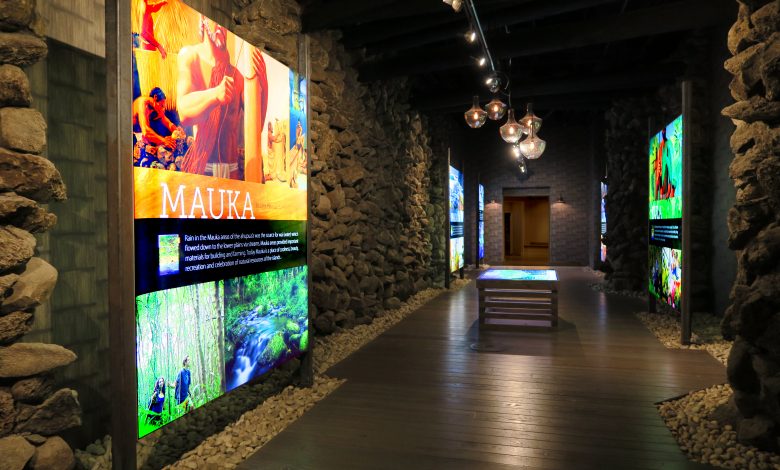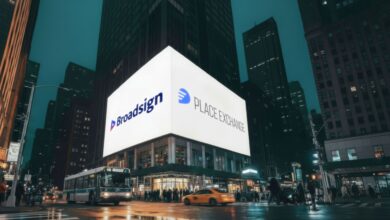SEG Takes the Backlit Market by Storm
Lightweight fabrics and framing systems shed new light on displaying backlit graphics
Silicone edge graphics, better known as SEG, is a printed fabric graphic with a thin silicone beading sewn neatly around the edges that fit easily into a frame. This booming graphics segment continues to become the choice for many types of backlit applications.
Over the last few years fabric has become an ideal alternative to traditional printed Duratrans for large backlit signage due to its light diffusion properties. When the edges of the backlit fabric graphic are sewn with silicone beading and stretched taut over an edgeless light box frame, the illuminated fabric displays the image with a smooth, frameless look. Backlit fabric allows for vibrant color, text clarity and contrast that allows for images to really pop.
Flexible fabrics
Jonathan Ramirez, production manager at Visual Solutions Group in Ontario, California, says there are many benefits to using SEG over other methods including for storage and shipping, due to the fact that fabric is lighter than many other graphics media on the market. “When folded neatly, fabric graphics take up much less space than traditional direct print graphics. Fabric graphics can be washed and steamed and are more durable and long lasting than many traditional graphic materials. Typically clients are happy with the fact that there is more ‘image’ for their dollar. There is also the ‘green’ aspect as there are numerous choices of fabric that are made with recycled materials.”
Ramirez adds that there is a wide variety of media being used depending on whether things will be backlit or not. “We work with clients to determine what we believe would be the best media for each individual project. Most recently, I’ve seen more media being run through our UV printer due to the color being more vibrant when it’s backlit.”
He adds that SEG fabrics can be applied to most display or event structures. They are great for media walls or any backdrop that is being photographed or filmed due to the fact there is no glare. However, the largest amounts of SEG signage we produce are for trade show displays.”
What is SEG?
Mike Compton, product marketing manager at Top Value Fabrics (TVF) based in Carmel, Indiana, says that silicone edge technology is a process where a thin strip of silicone (also known as Keder) is applied to the edges of a finished graphic. “The typical way of applying silicone edge to the graphic is by sewing it to the outer edge on all sides of a finished print. This can be done manually or with highly automated equipment depending on the print service provider’s volume.”
Easy to work with
He points out that once a graphic has silicone edge fastened to a graphic, it easily snaps into grooves on a variety of frame systems, which can be frontlit or backlit. “It is important to keep in mind that fabric with equal dimensional stretch is used in frontlit and backlit SEG graphics. Dimensional stretch ensures that the finished print fits tightly into the frame without sagging, bunching along the edges, or torqueing that ultimately skew the graphic.”
He explains that SEG backlit graphics are created by printing on a properly coated fabric that eliminates hot spots and pin holes from the LED lights that illuminate the graphic from behind. He adds that properly printing a backlit fabric with coating includes creating the proper color profile as well as adjusting the temperature and dwell time on your heat calendar.
“Consulting with your fabric supplier is the key to successfully printing stunning backlit graphics. Top Value Fabrics recommends selecting warp knit fabrics such as our Microlux Soft 8179WGFS, our new Microlux 240 8169WGFS, Supernova, or Lightbox Fabric Elite for this application as opposed to woven fabrics. Warp knit fabrics provide dimensional stability, are tightly knit, and are very durable for frame applications.”
He adds that alternatively, woven fabrics have a tendency to reveal hot spots and pin holes when viewed at an angle and are also more prone to tearing when stretched to fit into a frame. Tearing typically occurs due to the fabric’s construction, as warp knits feature a locking stitch that prevents tearing and woven fabrics do not.
Growing demand for frontlit
Compton says they see a demand for both frontlit and backlit SEG fabric applications continuing to grow, thus dramatically changing the landscape of the backlit market. “As more print service providers adopt backlit fabrics for SEG frame systems, the growth across the digital printing industry continues to explode. This is evidenced by consistent sales increases in backlit applications as well as by savvy print service providers developing products for new markets.”
“Backlit graphics have traditionally been utilized in trade show displays and retail applications for in-store retail P.O.P. and marketing. However, the use of backlit graphics has expanded well beyond the initial applications and will be an area of exponential growth in the digital printing industry for years to come.”
Direct LED frames
SEG frames are made mostly using aluminum connector systems and are available with LED lighting. Jason Urso, marketing manager at Direct LED Frames, San Marcos, California, says that they design framing systems for P.O.P., trade shows and other retail applications. “SEG has been around for a while in Europe and is now beginning to grow in popularity in the U.S., especially over the past three years. Even some big box retailers are entering the mix.”
He notes that SEG backlit displays tend to be much more vibrant and give the image more of a pop.
“About 95% of the work we do is custom frames,” Urso says. “Our lightweight aluminum frames for SEG framing systems are economical, durable, and easy to transport and install. Teamed with our optional extension sets and installation accessories, presentation displays become infinitely customizable.”
He adds that while they best known for its custom aluminum SEG system frames, they also have a selection of more than 700 wood frames ranging from elegant gold leaf styles to exotic veneer woods from around the world. “While we do not offer SEG printing at this time, we can also connect companies with a host of top-notch print service providers.”
SEG systems
Another major player in this area is Charlotte, North Carolina-based SEG Systems. The company is well known for the production of aluminum frames with fabric graphics, but has also moved into the use of wood, acrylic and steel. With 35 stocked extrusion profiles, 11 types of lighting technologies, and custom size options, they offer a wide array of design possibilities to suit customer needs. The company states on its website that its is taking its products a step further by adding 3D elements such as TV mounts, brackets, shelves, acrylic vitrines and dimensional letters.
Fabrics are the game changer
“While many manufacturers and suppliers will list a variety of fabrics as being backlit or frontlit SEG capable, there are certainly differences in what can be achieved with a printed graphic on the proper fabric — especially in backlit applications,” TVF’s Compton points out. “While some print service providers may make a decision simply based on the cost of the fabric, there are critical factors to consider when choosing a fabric from your supplier,” he adds.
He explains that its most popular backlit fabrics are warp knits with optical brighteners added in production. “Our fabrics also feature a diffuser coating as well as certified fire-resistant coatings. For example, our warp knit fabrics such as our Microlux Soft 8179WGFS feature a knitted-in microfiber that makes the fabric very forgiving, especially in applications where backlit fabrics are removed and re-installed on a regular basis. A warp knit construction provides the essential equal dimensional stretch for SEG frame systems without skewing of the image, sagging, bunching along the frame edges or corners, and also produces a very soft hand in the fabric. Our proprietary coatings ensure consistency from batch to batch enabling print service providers to produce brilliant graphics time after time. The coatings also eliminate pin holes and hot spots from LED lights which detract from a finished image.”
Compton adds that popular applications include trade show booth displays, in-store retail promotions, POP, and event backdrops. “Backlit applications continue to expand and can be found in major transportation venues such as airports, sports arenas, museums, interior décor, ceiling panels, and architectural applications. Frame manufacturers continue to offer new systems in many different shapes, profiles, and colors enabling print service providers to continue to penetrate new markets.”
Applying SEG
Ramirez says that working with and applying SEG graphics can be a little tricky at first. “Generally, we start off by inserting all four corners in about 12 inches on each side. Once these are in, we work our way toward the center from each side. It is important not to stretch the silicon or the fabric-this will result in having wrinkles on the edges or having excess material left over.”
Compton adds that when applying backlit SEG fabrics, it’s critical to start with a properly coated, optic white fabric with dimensional stretch. “It’s important that the silicone edges are accurately sewn to the graphic. If the silicone edge is sewn too rigid or too flexible it will cause the graphic to break or excessively stretch. Be sure to analyze the stretch capability of the fabric in the length and width to help the print service provider measure for precise cutting and sewing when applying silicone edging. It is also imperative to understand the dimensions of the frame system that the printed graphic will be installed in. Relying on a consistent backlit fabric is the key to success.”
He says that once a print service provider becomes more comfortable with the characteristics of their fabrics, it becomes easy to continue to print new graphics for their clients as the need arises to change out prints for promotions and advertising. “It also allows their clients to change out the graphics themselves with little effort. We highly recommend you work with your supplier to select the proper fabric for your end-use application.”
Planet Tradeshow’s Out of this World
Compton says that one of TVF’s top-end users is Ball Ground, Georgia-based Planet Tradeshow/Meno Enterprises. Mike Rogers, national sales director, explains they consistently print on several TVF backlit fabrics including Supernova and Microlux Soft for backlit displays. “We recently printed their new Microlux 240 with excellent results and found it to be easily printable and very forgiving when handling. Our clients expect and receive the highest quality images with rich, brilliant colors with TVF backlit fabrics, and we appreciate their continuous technical support,” Rogers reports.









